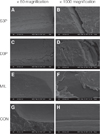1. Takamizawa T, Barkmeier WW, Tsujimoto A, Scheidel D, Erickson RL, Latta MA, Miyazaki M. Mechanical properties and simulated wear of provisional resin materials. Oper Dent. 2015; 40:603–613.


2. Gough M. A review of temporary crowns and bridges. Dent Update. 1994; 21:203–207.
3. Fisher DW, Shillingburg HT Jr, Dewhirst RB. Indirect temporary restorations. J Am Dent Assoc. 1971; 82:160–163.


4. Melton D, Cobb S, Krell KV. A comparison of two temporary restorations: light-cured resin versus a self-polymerizing temporary restoration. Oral Surg Oral Med Oral Pathol. 1990; 70:221–225.


5. Shillingburg HT, Sather DA, Wilson EL, Cain JR, Mitchell DL, Blanco LJ, Kessler JC. Fundamentals of fixed prosthodontics. 4th ed. Chicago: Quintessence Publishing;2012. p. 149–163.
6. Nigel Tom T, Uthappa MA, Sunny K, Begum F, Nautiyal M, Tamore S. Provisional restorations: An overview of materials used. J Adv Clin Res Insights. 2016; 3:212–214.

7. van Dijken JW. Direct resin composite inlays/onlays: an 11 year follow-up. J Dent. 2000; 28:299–306.


8. Seo HS, Park JW, Hong SM, Lee SR. Comparative analysis of immediate functional loading and conventional loading about implant survival rate in the completely edentulous: Retrospective study. J Korean Dent Assoc. 2014; 52:771–782.
9. Bennani V. Fabrication of an indirect-direct provisional fixed partial denture. J Prosthet Dent. 2000; 84:364–365.


10. Song KY, Sorensen JA. Marginal adaptation of new provisional materials for fixed prosthodontics. J Korean Acad Stomatognathic Funct Occlusion. 1997; 13:247–255.
11. Lee S. Prospect for 3D printing technology in medical, dental, and pediatric dental field. J Korean Acad Pediatr Dent. 2016; 43:93–108.

12. Strub JR, Rekow ED, Witkowski S. Computer-aided design and fabrication of dental restorations: current systems and future possibilities. J Am Dent Assoc. 2006; 137:1289–1296.

13. Kim SJ, Jo KH, Lee KB. A comparison of the fidelity of various zirconia-based all-ceramic crowns fabricated with CAD/CAM systems. J Korean Acad Prosthodont. 2009; 47:148–155.

14. van Noort R. The future of dental devices is digital. Dent Mater. 2012; 28:3–12.


15. Landers R, Pfister A, Hübner U, John H, Schmelzeisen R, Mülhaupt R. Fabrication of soft tissue engineering scaffolds by means of rapid prototyping techniques. J Mater Sci. 2002; 37:3107.
16. Barry B. 3-D printing: The new industrial revolution. Business Horizons. 2012; 55:155–162.

17. Santosa RE. Provisional restoration options in implant dentistry. Aust Dent J. 2007; 52:234–242.

18. Givens EJ Jr, Neiva G, Yaman P, Dennison JB. Marginal adaptation and color stability of four provisional materials. J Prosthodont. 2008; 17:97–101.


19. Fox CW, Abrams BL, Doukoudakis A. Provisional restorations for altered occlusions. J Prosthet Dent. 1984; 52:567–572.


21. Suwannaroop P, Chaijareenont P, Koottathape N, Takahashi H, Arksornnukit M. In vitro wear resistance, hardness and elastic modulus of artificial denture teeth. Dent Mater J. 2011; 30:461–468.


22. Park JM, Ahn JS, Cha HS, Lee JH. Wear resistance of 3D printing resin material opposing zirconia and metal antagonists. Materials (Basel). 2018; 11:1043.

23. Astudillo Rubio D, Delgado Gaete A, Bellot-Arcís C, Montiel-Company JM, Pascual-Moscardó A, Almerich-Silla JM. Mechanical properties of provisional dental materials: A systematic review and meta-analysis. PLoS One. 2018; 13:e0193162.

24. Tahayeri A, Morgan M, Fugolin AP, Bompolaki D, Athirasala A, Pfeifer CS, Ferracane JL, Bertassoni LE. 3D printed versus conventionally cured provisional crown and bridge dental materials. Dent Mater. 2018; 34:192–200.


25. Alharbi N, Osman R, Wismeijer D. Effects of build direction on the mechanical properties of 3D-printed complete coverage interim dental restorations. J Prosthet Dent. 2016; 115:760–767.


27. Alharbi N, Osman RB, Wismeijer D. Factors influencing the dimensional accuracy of 3D-printed full-coverage dental restorations using stereolithography technology. Int J Prosthodont. 2016; 29:503–510.


28. Lambrechts P, Braem M, Vuylsteke-Wauters M, Vanherle G. Quantitative in vivo wear of human enamel. J Dent Res. 1989; 68:1752–1754.


29. Yi HJ, Jeon YC, Jeong CM, Jeong HC. An in-vitro wear study of indirect composite resins against human enamel. J Korean Acad Prosthodont. 2007; 45:611–620.
30. Kern M, Strub JR, Lü XY. Wear of composite resin veneering materials in a dual-axis chewing simulator. J Oral Rehabil. 1999; 26:372–378.


31. Heintze SD, Zappini G, Rousson V. Wear of ten dental restorative materials in five wear simulators--results of a round robin test. Dent Mater. 2005; 21:304–317.


32. DeLong R, Sakaguchi RL, Douglas WH, Pintado MR. The wear of dental amalgam in an artificial mouth: a clinical correlation. Dent Mater. 1985; 1:238–242.


33. Alt V, Hannig M, Wöstmann B, Balkenhol M. Fracture strength of temporary fixed partial dentures: CAD/CAM versus directly fabricated restorations. Dent Mater. 2011; 27:339–347.


34. Albashaireh ZS, Ghazal M, Kern M. Two-body wear of different ceramic materials opposed to zirconia ceramic. J Prosthet Dent. 2010; 104:105–113.


35. Chadwick RG. Thermocycling-the effects upon the compressive strength and abrasion resistance of three composite resins. J Oral Rehabil. 1994; 21:533–543.


36. Mair LH, Stolarski TA, Vowles RW, Lloyd CH. Wear: mechanisms, manifestations and measurement. Report of a workshop. J Dent. 1996; 24:141–148.


37. Bae EJ, Jeong ID, Kim WC, Kim JH. A comparative study of additive and subtractive manufacturing for dental restorations. J Prosthet Dent. 2017; 118:187–193.


38. Park C, Kim MH, Go JS, Hong SM, Shin BS. A study on the comparison mechanical properties of 3D printing prototypes with laminating direction. J Manuf Eng Technol. 2015; 24:334–341.









 PDF
PDF ePub
ePub Citation
Citation Print
Print






 XML Download
XML Download